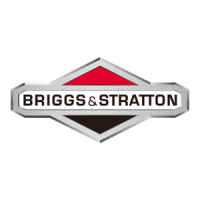7
1. Make sure water pump is on a level surface.
2. Clean area around fuel fill cap and remove cap.
3.
Slowly add regular unleaded fuel (A) to fuel tank (B).
Be careful not to overfill. To allow for fuel expansion,
do not fill above the bottom of the fuel tank neck.
4. Install fuel cap and let any spilled fuel evaporate
before starting engine.
At altitudes over 1524 meters (5,000 feet), a minimum
85 octane / 85 AKI (89 RON) gasoline is acceptable. To
remain emissions compliant, high altitude adjustment is
required. Operation without this adjustment will cause
decreased performance, increased fuel consumption, and
increased emissions. See an Authorized Briggs & Stratton
dealer for high altitude adjustment information. Operation of
the engine at altitudes below 762 meters (2,500 feet) with
the high altitude kit is not recommended.
You will need the following tool to install the hoses to the
water pump:
• 10 mm nut driver
Use a commercially available hose. The suction hose
must be reinforced with a non-collapsible wall or braided
material. DO NOT use a hose with an inside diameter
smaller than the pumps suction port size.
1. Slide barb cuff over hose barb. Insert rubber seal
into end of barb cuff. Figure
2.
Screw hose barb assembly onto pump in clockwise
rotation until hose barb assembly is tightened securely.
Figure
3. Slide hose clamp over end of hose. Slide suction hose
onto hose barb. Tighten hose clamp securely using a
standard 10 mm nut driver. Figure
Figure
Slide hose clamp over hose. Attach open end of suction
hose to strainer hose barb. Tighten hose clamp securely
using a standard 10 mm nut driver.
If desired, use a commercially available hose. DO NOT
use a hose with an inside diameter smaller than the
pump’s discharge port size.
1. Slide barb cuff over hose barb. Insert rubber seal
into end of barb cuff.
2. Screw hose barb assembly onto pump in clockwise
rotation until hose barb assembly is tightened
securely. Figure
3. Slide hose clamp over end of discharge hose.
Slide discharge hose onto hose barb. Tighten hose
clamp securely using a standard 10 mm nut driver.
Figure
Figure
For best pump performance, locate the pump on a flat,
level surface as close as possible to the water to be
pumped. Secure water pump to avoid tipover. Use hoses
that are no longer than necessary.
WARNING Exhaust heat/gases could ignite
combustibles, structures or damage fuel tank
causing a fire, resulting in death or serious
injury.
• Keep at least 1.5 m (5 ft) of clearance on all sides of
water pump including overhead.
Carbon Monoxide Poisoning
WARNING POISONOUS GAS HAZARD. Engine
exhaust contains carbon monoxide, a poisonous
gas that could kill you in minutes. You CANNOT
see it, smell it, or taste it. Even if you do not smell
exhaust fumes, you could still be exposed to carbon
monoxide gas. If you start to feel sick, dizzy or weak while
using this product, get to fresh air RIGHT AWAY. See a
doctor. You may have carbon monoxide poisoning.
• Operate this product ONLY outside far away from
windows, doors and vents to reduce the risk of
carbon monoxide gas from accumulating and
potentially being drawn towards occupied spaces.
• Install battery-operated carbon monoxide alarms or
plug-in carbon monoxide alarms with battery back-up
according to the manufacturer’s instructions. Smoke
alarms cannot detect carbon monoxide gas.
• DO NOT run this product inside homes, garages,
basements, crawlspaces, sheds, or other partially-
enclosed spaces even if using fans or opening doors
and windows for ventilation. Carbon monoxide can
quickly build up in these spaces and can linger for
hours, even after the product has shut off.
• ALWAYS place this product downwind and point the
engine exhaust away from occupied spaces.
Head refers to the height of a column of water that can
be delivered by the discharge of the pump.
(A) is the vertical distance between the
center of the pump and the surface of the liquid on the
suction side of the pump. May also be referred to as
“suction lift”. The atmospheric pressure of 1 bar (14.5
psi) at sea level limits suction head lift to less than
approximately 8m (26 ft) for any pump.
Discharge Head (B) is the vertical distance between the
pump’s discharge port and the point of discharge, which
is the liquid surface if the hose is submerged or pumping
into the bottom of a tank.
As water pumping height increases, pump output
decreases. The length, type, and size of the suction and
discharge hoses can also significantly affect pump output.
It is important for the suction operation to be the shorter
part of the total pumping action. This will decrease
the priming time and improve pump performance by
increasing the discharge head.
See Specifications for maximum head values.
11
12
7
8
9
10
13
16

